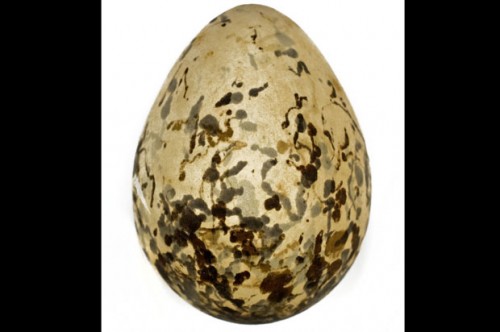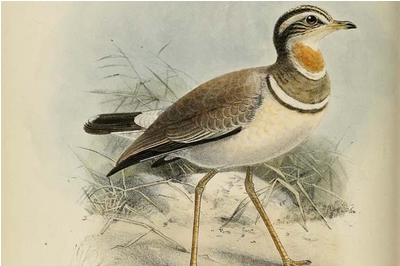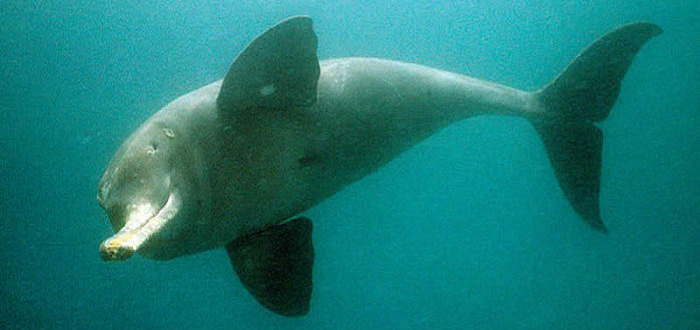Scientist in Scotland stumbles upon Critically Endangered Indian Bird’s Egg
RARE DISCOVERY: In the drawers of the Zoology museum of the University of Aberdeen, lay an egg, preserved but uncatalogued and unrecognised, until Dr Alan Knox found it and sent it for DNA analysis. What he discovered he aptly describes as a ‘eureka moment’ in science. Because the egg is the one and only specimen seen for the first time in the world of a Critically Endangered Indian bird, Jerdon’s Courser!

A nocturnal bird, the Jerdon’s Courser (Rhinoptilus bitorquatus ) has a small habitat in southern Andhra Pradesh in India – the Godaveri river valley near Sironcha and Bhadrachalam,and the Cuddapah and Anantapur areas in the valley of the Pennar river.
After its initial discovery in 1848 by Brtish ornithologist and surgeon Thomas Jerdon who gave the bird its name, it was again seen in 1871 and in 1900. After that for many years no one could spot the rare species and scientists feared that the bird had become extinct.
But in 1986 Bharat Bhushan a keen ornithologist saw the bird at Lankamalai which was then declared a sanctuary. The last known sighting was in 2009 by a researcher with Bombay Natural History Society (BNHS) Rahul Chavan.
Because the bird is so hard to spot in the wild, no recorded observations exists where someone has seen the bird’s nest or its eggs. Therefore, the egg found in the University of Aberdeen is truly a rarest of rare discovery.
How to Identify an Egg?

Dr. Knox found the egg stored among a collection that dates back to the 1900s.
“I was looking through drawers of uncatalogued eggs in the University’s Zoology Museum when I spotted an egg labelled as belonging to this species. It was one of those eureka moments – finding something nobody else knows about, something so rare and exciting. I could hardly believe my eyes,” Recalls the scientist.
Almost immediately he wanted to know more.
“My first question was how do you identify something that the books say has never been discovered?
“Very little is actually known about this extremely rare bird which inhabits an area only a few kilometres wide. It was seen only a few times in southern India before it was presumed extinct around 1900. It was rediscovered in 1986 but is listed as a critically endangered species. Without any others to compare it with, the process of correctly identifying the egg was a challenge.”
Dr. Knox believed the best answer would be at the Natural History Museum in Tring, Hertfordshire which has the largest egg collection in the world. Here, the egg was compared to other bird eggs and was found similar to other courser species but not an exact match.
The Jerdon’s Courser egg is 2-3cm long and is similar to the size of a small duck’s egg.
The next step was a DNA analysis and other tests.
DNA was extracted from dried up membrane very gently scraped from the inside of the egg. It was compared with DNA taken from the toe of a 140-year-old Jerdon’s Courser skin from Tring.
It took five long years of analysis, but the end result was a just reward. It was a match and confirmed that the egg belonged to the rare Indian bird.
Professor Stuart Piertney of the University’s Institute of Biological and Environmental Sciences, who carried out this delicate work said,
“It is extremely challenging to get DNA out of eggs from museum collections, but highly rewarding when it identifies something so very rare within our own museum. It also highlights what wonderful repositories of untapped information about the natural world museums can be, and how we can open it up using new technologies.”
Indian Bird’s Egg in Scotland
The singular egg surely had an adventurous life having travelled miles away from India to Scotland almost a century ago and yet in pristine condition today to allow such a startling discovery.

The egg is part of a small collection put together by Ernest Meaton, a veterinary surgeon working at the Kolar Gold Fields to the east of Bangalore, probably in 1917. His collection was bought by George Rose, a former pupil.
Rose, was born in Orkney, and was a successful engineer in the jute industry, based in Calcutta, India. He returned to Aberdeenshire to live at Tullich Lodge near Ballater, and at Auchernach in Strathdon. In 1919 he gave the collection including the egg to Aberdeen Grammar School.
The Grammar School gave the egg collection to the University in the 1970s where it lay unexamined for 30 years, until Dr Knox opened the drawers.
Dr Knox added,
“We are hoping the discovery will help conservationists working to save the species in India. They will now know what the eggs look like, and there is a possibility the species may still exist in scrub-jungle nearer to the Kolar Gold Fields.”
Details of the discovery have just been published in the Journal of the Bombay Natural History Society.
For those interested in seeing this rare find with their own eyes, the egg will be on display in the University’s Zoology Museum when the current refurbishment is completed.
To Know More about the Jerdon’s Courser see Jerdon’s Courser: A Precious Rarity
More Related Stories,
After 135 Years, Extinct Gecko Seen Again
14 Species of Birds on the Verge of Extinction
Poor Genetic Diversity Spelling Doom for Great Indian Bustard
Image courtesy Herald Scotland and BBC






One thought on “Rarest Egg in the World!”